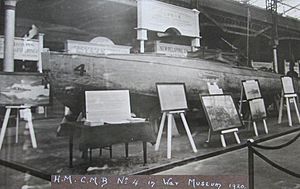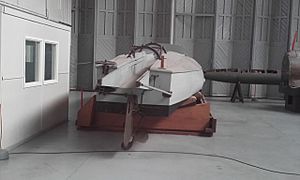HM Coastal Motor Boat 4 facts for kids

HM CMB No 4 in Imperial War Museum London (1920)
|
|
Quick facts for kids History |
|
|---|---|
| Name | HM Coastal Motor Boat 4 |
| Ordered | 1916 |
| Builder | John I. Thornycroft & Company |
| Acquired | 1916 |
| Out of service | 1919 |
| Status | Museum ship |
| General characteristics | |
| Type | Coastal Motor Boat |
| Displacement | 5 tons |
| Length | 45 ft (14 m) |
| Beam | 8 ft 6 in (2.59 m) |
| Draft | 2 ft 9 in (0.84 m) |
| Propulsion | 1 shaft Thornycroft V-12 petrol engine which developed 275 bhp (205 kW) |
| Speed | 24.8 kn (45.9 km/h; 28.5 mph) |
| Complement | 3 |
| Armament | 1 × 18-inch torpedo |
HM Coastal Motor Boat 4, often called CMB 4, was a special type of fast boat used by the British Navy. It became very famous during the First World War and later for a daring mission. This boat was a "torpedo boat," meaning it carried torpedoes to attack enemy ships.
CMB 4 is especially known because Lieutenant Augustus Agar used it for a brave raid. In this mission, he attacked Soviet warships in a place called Kronstadt. During this attack, he managed to sink a large ship called the cruiser Oleg. For his courage, Lieutenant Agar was awarded the Victoria Cross, a very high honor.
Contents
What is CMB 4?
CMB 4 was part of a group of small, very fast boats. They were designed to move quickly in shallow water. These boats were important during the First World War.
The company John I. Thornycroft & Company in Hampton, England, designed and built CMB 4. The order for the boat was placed in January 1916. It was ready and delivered to the navy in the summer of that same year.
A Special Design
CMB 4 was about 45 feet (14 m) (13.7 meters) long. It was 8 ft 6 in (2.59 m) (2.6 meters) wide. It weighed 5 tons and only needed 2 ft 9 in (0.84 m) (0.8 meters) of water to float. This shallow design helped it operate close to shore.
The boat had a powerful Thornycroft V-12 petrol engine. This engine produced 275 bhp (205 kW) (brake horsepower). It drove a single propeller, allowing the boat to reach a top speed of 24.8 knots (45.9 km/h) (46 km/h or 28.5 mph).
CMB 4 usually had a crew of three people. For attacking ships, it carried one 18-inch (450 mm) torpedo. When it attacked the Oleg, it also had two .303 inch (7.62 mm) Lewis machine guns.
Brave Missions and Heroes

Early Missions with Lieutenant Beckett
In May 1916, Lieutenant W. N. T. Beckett became the first commander of the new CMB 4. Later, in December 1916, he led a group of CMBs to Dunkirk. From there, they operated along the Belgian coast.
Lieutenant Beckett led a CMB attack on German destroyers at Zeebrugge on April 7, 1917. During this attack, one German destroyer was sunk, and another was badly damaged. For his bravery, Beckett was mentioned in official reports and received the Distinguished Service Cross (DSC).
The Famous Kronstadt Raid
CMB 4 became truly famous under the command of Lieutenant Augustus Agar. This was during the British operations in the Baltic Sea in 1919. These missions were against the Bolsheviks, who were fighting in Russia at the time. CMB 4 and its sister ships took part in important actions, like the raid on Kronstadt.
CMB 4 Today
After its important missions, CMB 4 was brought back to the United Kingdom. It was first shown at the Imperial War Museum in London. Later, it was displayed at the Vosper works on Platt’s Eyot, an island on the River Thames near Kingston. For many years, it even had a Victoria Cross painted on its side.
When the Vosper works closed, the boat was moved. It was carefully restored and then displayed at the Imperial War Museum Duxford. This museum is near Cambridge. At Duxford, the details of its famous actions were shared, but the painted Victoria Cross was removed.
In July 2019, CMB 4 moved again. It is now at Boathouse 4 in the Portsmouth Historic Dockyard. Here, it is displayed above a full-size, working copy of the boat. Volunteers are building this replica, and it is expected to be ready for testing in 2022. CMB 4 is still owned by the Imperial War Museum. It is currently on loan to Boathouse 4 until 2024.
Lieutenant Agar’s Victoria Cross medal is kept at the Imperial War Museum in London. In May 1996, CMB 4 was added to the National Register of Historic Vessels. This means it is part of the National Historic Fleet, a collection of important historic ships.
See also
- Harbour Defence Motor Launch
- Coastal Forces of the Royal Navy

